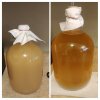I love how this thread just keeps on growing. I make this recipe on a regular basis. My family loves it as a sweetish table wine. Its good stuff.
I just wanted to keep this thread going.
Some additional flavors to the basic recipe that I have began to experiment with regarding the Welsh's recipe include...vanilla bean, toasted french oak and pure cherry extract. Given that the basic recipe is quite refreshing and one-dimensional - I wanted to see if I could build in some additional layers.
I also have found a concord concentrate supplier that sells bulk concentrate in 2.5 gallon
containers - the brix is higher than Welch's and much easier to work with. The result is a much richer deeper bodied concord wine.
I will never again use Welch's.
I just bottled 4 cases and am getting ready to get the next 4 case batch going. My problem is - I can't seem to stay out of it long enough to let it age!











































![Craft A Brew - Safale BE-256 Yeast - Fermentis - Belgian Ale Dry Yeast - For Belgian & Strong Ales - Ingredients for Home Brewing - Beer Making Supplies - [3 Pack]](https://m.media-amazon.com/images/I/51bcKEwQmWL._SL500_.jpg)






 The yeast choked out right @ Lalvin specs. ok I know my fault (too much sugar) I must learn how to follow instructions. But anyway, I tasted it and it is very sweet. Now is there anything I can do to fix this? or should I consider it a dessert wine?
The yeast choked out right @ Lalvin specs. ok I know my fault (too much sugar) I must learn how to follow instructions. But anyway, I tasted it and it is very sweet. Now is there anything I can do to fix this? or should I consider it a dessert wine?
